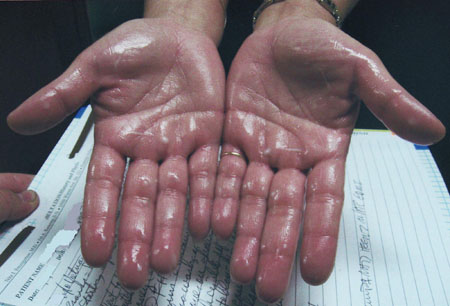History and exam
Key diagnostic factors
common
presence of risk factors
Key risk factors for primary hyperhidrosis include family history, high emotional states, hot or humid climates.
Key risk factors for secondary hyperhidrosis include drugs and substance abuse, endocrine disorders, cardiovascular diseases, hypoglycaemia, menopause, infectious diseases, sepsis, neoplastic diseases, carcinoid tumours, and neurological injuries.
excessive palmar sweating
Mild disease is a moist palmar surface without visible droplets of perspiration. If palmar sweating extends towards the fingertips, the condition can be considered moderate. If sweat drips off the palm and reaches all the fingertips it is severe. [Figure caption and citation for the preceding image starts]: Profound sweating provoked in a patient with palmoplantar hyperhidrosis after administration of a small amount of hand lotionFrom the personal collection of Fritz Baumgartner, MD [Citation ends].
excessive plantar sweating
Moist socks and shoes.
In some patients, soles of feet sweat to a level approximating excessive palmar sweating.
onset in early childhood or puberty
exacerbation of palmar sweating with use of hand lotion
Usually, patients with a history for palmoplantar (or palmar) hyperhidrosis present with completely dry hands. However, on application of ordinary hand lotion, their palms sweat profusely within minutes. [Figure caption and citation for the preceding image starts]: Profound sweating provoked in a patient with palmoplantar hyperhidrosis after administration of a small amount of hand lotionFrom the personal collection of Fritz Baumgartner, MD [Citation ends].
severe facial sweating
Occurs in patients with primary facial hyperhidrosis.
severe axillary sweating
Occurs in patients with primary axillary hyperhidrosis.
generalised sweating
Secondary hyperhidrosis tends to occur as a more generalised all-over body sweating.
Risk factors
strong
family history
medications
Several types of medications can cause secondary hyperhidrosis as a side effect. These include insulin, meperidine, emetics, cholinesterase inhibitors, selective serotonin reuptake inhibitors, opioids, propranolol, pilocarpine, and physostigmine.
endocrine disorders
Generalised secondary hyperhidrosis may be caused by disorders of the thyroid, pituitary, pancreas, or adrenal glands (e.g., thyrotoxicosis, pituitary tumours, diabetes, or phaeochromocytoma).
cardiovascular diseases
Cardiovascular disorders, including congestive heart failure, acute coronary syndrome, and rhythm disorders, may cause generalised secondary hyperhidrosis.
hypoglycaemia
May cause generalised secondary hyperhidrosis.
menopause
May cause secondary hyperhidrosis or hot-flushes.
infectious diseases
Infectious diseases such as tuberculosis and malaria may cause generalised secondary hyperhidrosis.
sepsis
Septic states can cause secondary hyperhidrosis.
neoplastic diseases
May cause generalised secondary hyperhidrosis. For example, a patient with a neoplasia such as a lymphoma may have extensive night sweats of the entire body, lymphadenopathy, and shaking chills.
carcinoid tumours
May cause generalised secondary hyperhidrosis.
neurological injuries
May cause focal secondary hyperhidrosis. Injuries such as acute spinal cord injury, cerebral or medullary infarcts, or other nerve injuries (e.g., post-traumatic vasomotor dystrophy) may cause focal sweating. In addition, Frey's syndrome (sweating on one side of the forehead, face, scalp, and neck occurring soon after ingesting food as a result of damage to the nerve that innervates the parotid gland) may cause facial gustatory sweating.
weak
spicy foods
May provoke the symptoms of primary hyperhidrosis, particularly the focal craniofacial variety.
obesity
Although obesity is not a direct cause of hyperhidrosis, it may lead to a condition of generalised secondary hyperhidrosis.
Use of this content is subject to our disclaimer